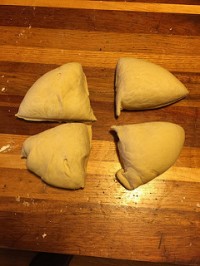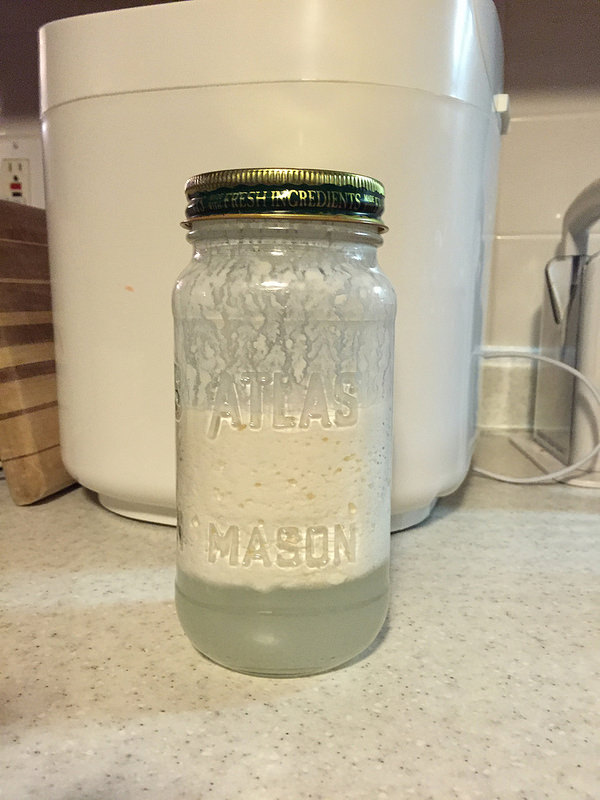These bagels were made on May 15.
This week’s bagel kicks off a journey into some odd territory: recipes not from bread books, nor from bagel books, but from what I will call Standard Cookbooks of the American Midwest. It’s from Joy of Cooking, which is not a cookbook I knew when I was growing up. But after I got married and figured it was time to learn how to cook, I started looking around at upscale cookbooks. Most of their authors eventually referenced Joy, so I bought my own copy (before the revised edition that came out around 1998). It certainly is a comprehensive labor of love, and it covers most anything you would need to make in a kitchen, from cocktails to chocolate cake and any kind of meat in between. It contains no superfluous illustrations, so the introductory paragraphs for the recipes and the sections stand out a bit more, especially when they contain amusing anecdotes.
Joy of Cooking is a classic, and a handy book, but should you turn to it to learn how to make a bagel? Well, the jury’s still out.
This recipe looked a bit odd from the start: the first four ingredients were scalded milk, butter, sugar, and salt. Son One was helping out with the bagel prep this time. He eyed the saucepan and asked pointedly, “Why are you heating up milk?”
Well, because the recipe says so, that’s why. This weekend we’re following the recipe as closely as we can and hoping that we don’t end up like a trusting elderly couple who follow the voice of their GPS unit and drive straight into a lake. Scald milk? Sure! Add butter? If you say so! Son One commented, “It smells like we’re making macaroni and cheese.”
The next step was to add a packet of yeast to the warm milk mixture. The milk was hotter than the recommended temperature range when I took it off the stove, but adding the butter cooled it to below the range. No matter — I just let the yeast hang out there a little longer and keep developing.

Actually, after adding two eggs and a few cups of flour to the batter I had, it all developed into a picture-perfect bread dough that was wonderful to knead for ten minutes. A few sprinklings of flour — unbleached all-purpose in this case — were all that was needed to rid it of stickiness.

Next, the dough was left to rise, covered, until it had doubled in size. I didn’t know how long that would take, and I was dividing my time between bagels and watching qualifying sessions for the Spanish Grand Prix, so I set a timer for 30 minutes since that was the typical rest time for the other bagel recipes.

At the end of thirty minutes’ time, I hopped back into the kitchen…to discover that I had a nicely developed ball of dough to work with, and that I had completely neglected to start the water boiling. I got the water going, checked the recipe, and noticed that the formed bagels were supposed to rest for fifteen minutes before hitting the water. That was plenty of time for the water to come to the boil, right?
Well, it wasn’t, actually, but I don’t think it did the bagels much harm to wait a bit longer (even if they weren’t technically bagels yet). Anyway, the recipe said that I would be making 18 bagels from this dough. While 18 is a special number indeed, it’s not easy for me to bake 18 bagels, as two half-sheet pans won’t fit in my oven, and staggering the baking sheets and switching racks forces me to open the oven more often than I’d like during the baking time, losing a lot of the valuable 400°F heat and doing goodness knows what to the texture of the bagels.
Plus, how do you divide dough into 18 equal portions? Without a great deal more experience and a very good scale — and my scale recently went to scale heaven (Toledo, Ohio?) — I can’t. But here’s how I tried to make 16 equal portions:



Ah, fractions. Is there anything they can’t do?

The bagels rose for a while as the water in my stock pot came up to the boil. When that water, supplemented with a tablespoon of sugar, was ready, it was really ready.
I slipped bagels in two at a time, then flipped them and slipped in two more. After three minutes had passed, I took the first set out, flipped the second set, and put two more bagels in the water. They plumped up very well except for a straggler that will be obvious in a later photo.

Fitting all the bagels on a single sheet was a bit of a challenge. Thank goodness I spent what seemed like years of my college “career” playing Tetris on an IBM PC. Quick, quick, the boss is coming!


I baked the bagels for 25 minutes, the high end of the time the recipe suggested. In the end they looked a little fluffy, and that may have been because they were so close together that they steamed themselves. They only developed a crispy crust right on their tops. Really, I didn’t give them anywhere else to go.

While the recipe was fairly easy to follow, the ingredients were easy to find, and the dough was exceptionally easy to work with, these bagels were evidence that taking the “easy” way doesn’t really produce what I would call a bagel of character. The texture was fluffy rather than chewy, the all-purpose flour didn’t provide much flavor (even with the inclusion of two eggs in the dough), and there was nothing special about them in general.
On the other hand, I took most of them to work and they were soon gobbled up. Nobody complained. If you make the perfect bagel and nobody eats it, is it still a bagel?

